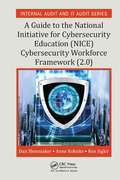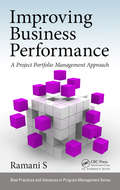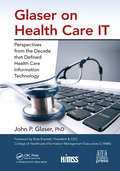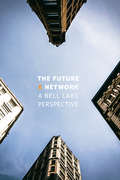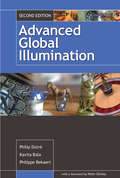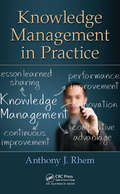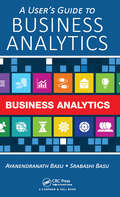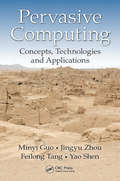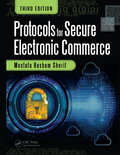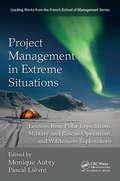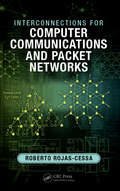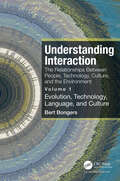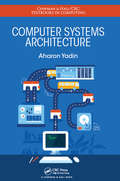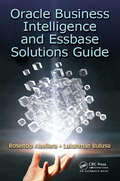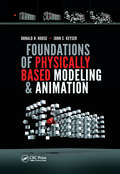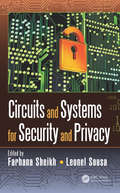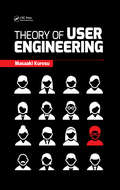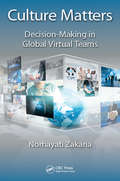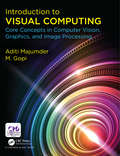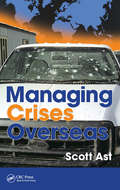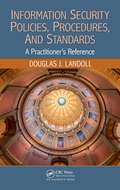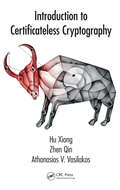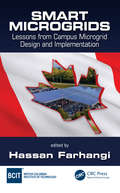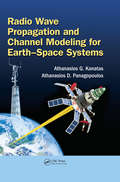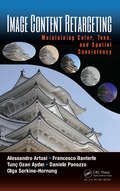- Table View
- List View
A Guide to the National Initiative for Cybersecurity Education: A Guide To The National Initiative For Cybersecurity Education (nice) Framework (2. 0) (Security, Audit and Leadership Series)
by Dan Shoemaker Anne Kohnke Ken SiglerA Guide to the National Initiative for Cybersecurity Education (NICE) Cybersecurity Workforce Framework (2.0) presents a comprehensive discussion of the tasks, knowledge, skill, and ability (KSA) requirements of the NICE Cybersecurity Workforce Framework 2.0. It discusses in detail the relationship between the NICE framework and the NIST’s cybersecurity framework (CSF), showing how the NICE model specifies what the particular specialty areas of the workforce should be doing in order to ensure that the CSF’s identification, protection, defense, response, or recovery functions are being carried out properly. The authors construct a detailed picture of the proper organization and conduct of a strategic infrastructure security operation, describing how these two frameworks provide an explicit definition of the field of cybersecurity. The book is unique in that it is based on well-accepted standard recommendations rather than presumed expertise. It is the first book to align with and explain the requirements of a national-level initiative to standardize the study of information security. Moreover, it contains knowledge elements that represent the first fully validated and authoritative body of knowledge (BOK) in cybersecurity. The book is divided into two parts: The first part is comprised of three chapters that give you a comprehensive understanding of the structure and intent of the NICE model, its various elements, and their detailed contents. The second part contains seven chapters that introduce you to each knowledge area individually. Together, these parts help you build a comprehensive understanding of how to organize and execute a cybersecurity workforce definition using standard best practice.
Improving Business Performance: A Project Portfolio Management Approach (Best Practices in Portfolio, Program, and Project Management)
by Ramani SNo organization is impervious to change. Rather, the survival and growth of an organization is dependent on how well it copes with change. Successful change initiatives consist of the integrated eco-system of its portfolio, programs, and projects. These change initiatives become the delivery mechanisms for implementing the strategy of an organization.Improving Business Performance: A Project Portfolio Management Approach clarifies how the proper application of portfolio, program, and project management concepts can help commercial and non-profit organizations achieve their strategic objectives. Most organizations have been good at devising strategy, but falter during its implementation. Executing strategy well to deliver superior business performance remains a key challenge, which is addressed as the core theme of this book.The book portrays a top-down orientation as well as a bottom-up integration of change initiatives to facilitate alignment to strategy and accommodate mid-course changes. It takes into account existing global best management practices to bring forth an approach that is customizable and useful to organizations in any industry.Describing why portfolio management lies at the apex of change initiative management, the book explains how to design and fine-tune portfolios so they are in alignment with your organization’s overall strategy and business needs. After reading this book, you will understand: How to design the project portfolio structure for your organization How to integrate programs and projects within the portfolio more effectively How to better manage interactions across diverse change initiatives How to maintain focus while managing change to realize benefits The book presents a case study that illustrates the application of project portfolio concepts in practical scenarios. It includes chapters dedicated to transition management, change management, benefits management, and the Enterprise Project Management Office. It also includes templates you can immediately put to use in your own portfolios, programs, and projects.
Glaser on Health Care IT: Perspectives from the Decade that Defined Health Care Information Technology (HIMSS Book Series)
by John P. GlaserJohn Glaser has been an astute observer and recognized leader in the health care industry for over thirty years. He has written a regular column for Hospitals & Health Networks in which he comments on a wide range of topics, including improving organizational performance through health information technology (HIT), changes in HIT architecture, challenges in leveraging data, and the evolution of the role of IT leadership. Glaser on Health Care IT: Perspectives from the Decade that Defined Health Care Information Technology is a collection of some of the most widely read articles that have been published in H&HN Daily, H&HN Weekly, and Most Wired Online in the past decade (2005–2015). The columns are dated to show their original publication dates, and the material is organized into four broad themes: HIT Applications and Analytics Challenges Improving Organizational Performance through HIT IT Management Challenges HIT Industry Observations Each section offers readers an intimate look at the myriad issues associated with getting IT "right" and the organizational performance gains that can be achieved in doing so. Moreover, the book examines the power and potential of the technologies available to health care providers today, as well as the transformative nature of those we have yet to fully embrace.From seasoned CIOs and consultants to software developers and nurses, this book provides invaluable insights and guidance to all those seeking to make the delivery of care safer, more effective, and more efficient through the application of health care IT.Foreword by Russ Branzell, President and CEO, College of Healthcare Information Management Executives (CHIME) Co-published with Health Forum, Inc.
The Future X Network: A Bell Labs Perspective
by Marcus K. WeldonWe are at the dawn of an era in networking that has the potential to define a new phase of human existence. This era will be shaped by the digitization and connection of everything and everyone with the goal of automating much of life, effectively creating time by maximizing the efficiency of everything we do and augmenting our intelligence with knowledge that expedites and optimizes decision-making and everyday routines and processes.The Future X Network: A Bell Labs Perspective outlines how Bell Labs sees this future unfolding and the key technological breakthroughs needed at both the architectural and systems levels. Each chapter of the book is dedicated to a major area of change and the network and systems innovation required to realize the technological revolution that will be the essential product of this new digital future.
Advanced Global Illumination
by Philip Dutre Philippe Bekaert Kavita BalaThis book provides a fundamental understanding of global illumination algorithms. It discusses a broad class of algorithms for realistic image synthesis and introduces a theoretical basis for the algorithms presented. Topics include: physics of light transport, Monte Carlo methods, general strategies for solving the rendering equation, stochastic path-tracing algorithms such as ray tracing and light tracing, stochastic radiosity including photon density estimation and hierarchical Monte Carlo radiosity, hybrid algorithms, metropolis light transport, irradiance caching, photon mapping and instant radiosity, beyond the rendering equation, image display and human perception. If you want to design and implement a global illumination rendering system or need to use and modify an existing system for your specific purpose, this book will give you the tools and the understanding to do so.
Knowledge Management in Practice
by Anthony J. Rhem"This evidence-based book provides the framework and guidelines that professionals need for working with the contemporary explosion of data that is creating opportunities and challenges to all phases of our society and commerce." –Larry R. Medsker, Research Professor in Physics and Data Science, The George Washington University Knowledge Management in Practice is a resource on how knowledge management (KM) is implemented. It provides specific KM methods, tips, techniques, and best practices to gain competitive advantage and the most from investing in KM. It examines how KM is leveraged by first responders, the military, healthcare providers, insurance and financial services companies, legal firms, human resources departments, merger and acquisition (M&A) firms, and research institutions. Essential KM concepts are explored not only from a foundational perspective but also from a practical application. These concepts include capturing and codifying tacit and explicit knowledge, KM methods, information architecture, search, KM and social media, KM and Big Data, and the adoption of KM. Readers can visit the book’s companion website, KM Mentor (www.KMMentor.com), where they can access: Presentations by industry leaders on a variety of topics KM templates and instruction on executing KM strategy, performing knowledge transfer, and KM assessments and audits KM program and project implementation guidance Insights and reviews on KM tools Guidance on implementing and executing various KM Methods Specialized KM publications A private secure collaboration community for members to discuss ideas and get expert answers and advice
A User's Guide to Business Analytics
by Ayanendranath Basu Srabashi BasuA User's Guide to Business Analytics provides a comprehensive discussion of statistical methods useful to the business analyst. Methods are developed from a fairly basic level to accommodate readers who have limited training in the theory of statistics. A substantial number of case studies and numerical illustrations using the R-software package are provided for the benefit of motivated beginners who want to get a head start in analytics as well as for experts on the job who will benefit by using this text as a reference book. The book is comprised of 12 chapters. The first chapter focuses on business analytics, along with its emergence and application, and sets up a context for the whole book. The next three chapters introduce R and provide a comprehensive discussion on descriptive analytics, including numerical data summarization and visual analytics. Chapters five through seven discuss set theory, definitions and counting rules, probability, random variables, and probability distributions, with a number of business scenario examples. These chapters lay down the foundation for predictive analytics and model building. Chapter eight deals with statistical inference and discusses the most common testing procedures. Chapters nine through twelve deal entirely with predictive analytics. The chapter on regression is quite extensive, dealing with model development and model complexity from a user’s perspective. A short chapter on tree-based methods puts forth the main application areas succinctly. The chapter on data mining is a good introduction to the most common machine learning algorithms. The last chapter highlights the role of different time series models in analytics. In all the chapters, the authors showcase a number of examples and case studies and provide guidelines to users in the analytics field.
Pervasive Computing: Concepts, Technologies and Applications (Lecture Notes in Computer Science #6646)
by Minyi Guo Jingyu Zhou Feilong Tang Yao ShenThis book introduces fundamental concepts and theories in pervasive computing as well as its key technologies and applications. It explains how to design and implement pervasive middleware and real application systems, covering nearly all aspects related to pervasive computing. Key technologies in the book include pervasive computing-oriented resource management and task migration, mobile pervasive transaction, human computer interface, and context collection-oriented wireless sensor networks.
Protocols for Secure Electronic Commerce (Advanced And Emerging Communications Technologies Ser.)
by Mostafa Hashem SherifProtocols for Secure Electronic Commerce, Third Edition presents a compendium of protocols for securing electronic commerce, or e-commerce, in consumer- and business-to-business applications. Attending to a variety of electronic payment systems currently in use around the globe, this edition: <Li>Updates all chapters to reflect the latest technical advances and developments in areas such as mobile commerce <Li>Adds a new chapter on Bitcoin and other cryptocurrencies that did not exist at the time of the previous edition's publication <Li>Increases the coverage of PayPal in accordance with PayPal’s amplified role for consumers and businesses <Li>Expands the discussion of bank cards, dedicating a full chapter to magnetic stripe cards and a full chapter to chip-and-PIN technology <P><P>Protocols for Secure Electronic Commerce, Third Edition offers a state-of-the-art overview of best practices for the security of e-commerce, complete with end-of-chapter review questions and an extensive bibliography of specialized references. A Solutions Manual and PowerPoint slides are available with qualifying course adoption.
Project Management in Extreme Situations: Lessons from Polar Expeditions, Military and Rescue Operations, and Wilderness Exploration (Leading Works from the French School of Management)
by Monique Aubry Pascal LievreThe growing complexity of projects today, as well as the uncertainty inherent in innovative projects, is making obsolete traditional project management practices and procedures, which are based on the notion that much about a project is known at its start. The current high level of change and complexity confronting organizational leaders and managers requires a new approach to projects so they can be managed flexibly to embrace and exploit change. What once used to be considered extreme uncertainty is now the norm, and managing planned projects is being replaced by managing projects as they evolve. <P><P>Successfully managing projects in extreme situations, such as polar and military expeditions, shows how to manage successfully projects in today’s turbulent environment. Executed under the harshest and most unpredictable conditions, these projects are great sources for learning about how to manage unexpected and unforeseen situations as they occur. This book presents multiple case studies of managing extreme events as they happened during polar, mountain climbing, military, and rescue expeditions. <P><P>A boat accident in the Artic is a lesson on how an effective project manager must be ambidextrous: on one hand able to follow plans and on the other hand able to abandon those plans when disaster strikes and improvise new ones in response. Polar expeditions also illustrate how a team can use "weak links" to go beyond its usual information network to acquire strategic information. Fire and rescues operations illustrate how one team member’s knowledge can be transferred to the entire team. Military operations provide case material on how teams coordinate and make use of both individual and collective competencies. <P><P>This groundbreaking work pushes the definitions of a project and project management to reveal new insight that benefits researchers, academics, and the practitioners managing projects in today’s challenging and uncertain times.
Interconnections for Computer Communications and Packet Networks
by Roberto Rojas-CessaThis book introduces different interconnection networks applied to different systems. Interconnection networks are used to communicate processing units in a multi-processor system, routers in communication networks, and servers in data centers. Queuing techniques are applied to interconnection networks to support a higher utilization of resources. There are different queuing strategies, and these determine not only the performance of the interconnection network, but also the set of requirements to make them work effectively and their cost. Routing algorithms are used to find routes to destinations and directions in what information travels. Additional properties, such as avoiding deadlocks and congestion, are sought. Effective routing algorithms need to be paired up with these networks. The book will introduce the most relevant interconnection networks, queuing strategies, and routing algorithm. It discusses their properties and how these leverage the performance of the whole interconnection system. In addition, the book covers additional topics for memory management and congestion avoidance, used to extract higher performance from the interconnection network.
Understanding Interaction: Volume 1: Evolution, Technology, Language and Culture
by Bert BongersUnderstanding Interaction explores the interaction between people and technology in the broader context of the relations between the human-made and the natural environments. It is not just about digital technologies – our computers, smartphones, the Internet – but all our technologies, such as mechanical, electrical, and electronic. Our ancestors started creating mechanical tools and shaping their environments millions of years ago, developing cultures and languages, which in turn influenced our evolution. Volume 1 looks into this deep history, starting from the tool-creating period (the longest and most influential on our physical and mental capacities) to the settlement period (agriculture, domestication, villages and cities, written language), the industrial period (science, engineering, reformation, and renaissance), and finally the communication period (mass media, digital technologies, and global networks). Volume 2 looks into humans in interaction – our physiology, anatomy, neurology, psychology, how we experience and influence the world, and how we (think we) think. From this transdisciplinary understanding, design approaches and frameworks are presented to potentially guide future developments and innovations. The aim of the book is to be a guide and inspiration for designers, artists, engineers, psychologists, media producers, social scientists, etc., and, as such, be useful for both novices and more experienced practitioners. Image Credit: Still of interactive video pattern created with a range of motion sensors in the Facets kaleidoscopic algorithm (based underwater footage of seaweed movement) by the author on 4 February 2010, for a lecture at Hyperbody at the Faculty of Architecture, TU Delft, NL.
Computer Systems Architecture (Chapman & Hall/CRC Textbooks in Computing)
by Aharon YadinComputer Systems Architecture provides IT professionals and students with the necessary understanding of computer hardware. It addresses the ongoing issues related to computer hardware and discusses the solutions supplied by the industry. The book describes trends in computing solutions that led to the current available infrastructures, tracing the initial need for computers to recent concepts such as the Internet of Things. It covers computers’ data representation, explains how computer architecture and its underlying meaning changed over the years, and examines the implementations and performance enhancements of the central processing unit (CPU). It then discusses the organization, hierarchy, and performance considerations of computer memory as applied by the operating system and illustrates how cache memory significantly improves performance. The author proceeds to explore the bus system, algorithms for ensuring data integrity, input and output (I/O) components, methods for performing I/O, various aspects relevant to software engineering, and nonvolatile storage devices, such as hard drives and technologies for enhancing performance and reliability. He also describes virtualization and cloud computing and the emergence of software-based systems’ architectures. Accessible to software engineers and developers as well as students in IT disciplines, this book enhances readers’ understanding of the hardware infrastructure used in software engineering projects. It enables readers to better optimize system usage by focusing on the principles used in hardware systems design and the methods for enhancing performance.
Oracle Business Intelligence and Essbase Solutions Guide
by Lakshman Bulusu Rosendo AbelleraThis book highlights the practical aspects of using Oracle Essbase and Oracle Business Intelligence Enterprise Edition (OBIEE) as a comprehensive BI solution. It explains the key steps involved in Oracle Essbase and OBIEE implementations. Using case studies, the book covers Oracle Essbase for analytical BI and data integration, using OBIEE for operational BI including presentation services and BI Publisher for real-time reporting services, Self-service BI– in terms of VLDB, scalability, high performance, stability, long-lasting and ease of use that saves time, effort, and costs, while maximizing ROI.
Foundations of Physically Based Modeling and Animation
by Donald House John C. KeyserPhysics forms the basis for many of the motions and behaviors seen in both the real world and in the virtual worlds of animated films, visual effects, and computer games. By describing the underlying physical principles and then creating simulations based on these principles, these computer-generated worlds are brought to life. Physically Based Modeling and Animation goes behind the scenes of computer animation and details the mathematical and algorithmic foundations that are used to determine the behavior underlying the movement of virtual objects and materials. Dr. Donald House and Dr. John Keyser offer an approachable, hands-on view of the equations and programming that form the foundations of this field. They guide readers from the beginnings of modeling and simulation to more advanced techniques, enabling them to master what they need to know in order to understand and create their own animations Emphasizes the underlying concepts of the field, and is not tied to any particular software package, language, or API. Develops concepts in mathematics, physics, numerical methods, and software design in a highly integrated way, enhancing both motivation and understanding. Progressively develops the material over the book, starting from very basic techniques, and building on these to introduce topics of increasing complexity. Motivates the topics by tying the underlying physical and mathematical techniques directly to applications in computer animation.
Circuits and Systems for Security and Privacy (Devices, Circuits, and Systems)
by Farhana Sheikh Leonel SousaCircuits and Systems for Security and Privacy begins by introducing the basic theoretical concepts and arithmetic used in algorithms for security and cryptography, and by reviewing the fundamental building blocks of cryptographic systems. It then analyzes the advantages and disadvantages of real-world implementations that not only optimize power, area, and throughput but also resist side-channel attacks. Merging the perspectives of experts from industry and academia, the book provides valuable insight and necessary background for the design of security-aware circuits and systems as well as efficient accelerators used in security applications.
Theory of User Engineering
by Masaaki KurosuThis book outlines the new concept of user engineering and covers the diversity of users, along with the business process that includes the design and the user’s experience processes. Although the concept of user experience (UX) has become popular, the definition and the methodology are still ambiguous. User engineering is similar to the user-centered design, but differs in that its scope is not limited to the design process but concerns the whole manufacturing process and the whole usage process, i.e., the whole lifecycle of an artifact. User’s perspective is strongly emphasized in this book, hence, its stance is far from that of the marketing approach that usually fails to notice the life and experiences of users after the purchase of an artifact as consumers. Theory of User Engineering differentiates between the quality in design and the quality in use, and the objective quality characteristics and the subjective quality characteristics. In addition to the user research using ethnographic methods, the author introduces a new approach based on the artifact evolution theory that can be adopted in the planning stage.
Culture Matters: Decision-Making in Global Virtual Teams
by Norhayati ZakariaGlobal virtual teams (GVTs) have evolved as a common work structure in multinational corporations due to their efficiency and cost-effectiveness. The cultural differences can produce great benefits in terms of perspective, creativity, and innovation, but can also exacerbate interpersonal tensions, miscommunications, and clashing decision-making behaviors. This book outlines cultural competencies specific to GVTs and sheds light on management strategies for creating an optimal inter-cultural GVT environment. It covers theory, decision making strategies, and activities for cultural competence and problem resolution, all told through vignettes and lessons-learned.
Introduction to Visual Computing: Core Concepts in Computer Vision, Graphics, and Image Processing
by Aditi Majumder M. GopiIntroduction to Visual Computing: Core Concepts in Computer Vision, Graphics, and Image Processing covers the fundamental concepts of visual computing. Whereas past books have treated these concepts within the context of specific fields such as computer graphics, computer vision or image processing, this book offers a unified view of these core concepts, thereby providing a unified treatment of computational and mathematical methods for creating, capturing, analyzing and manipulating visual data (e.g. 2D images, 3D models). Fundamentals covered in the book include convolution, Fourier transform, filters, geometric transformations, epipolar geometry, 3D reconstruction, color and the image synthesis pipeline. The book is organized in four parts. The first part provides an exposure to different kinds of visual data (e.g. 2D images, videos and 3D geometry) and the core mathematical techniques that are required for their processing (e.g. interpolation and linear regression.) The second part of the book on Image Based Visual Computing deals with several fundamental techniques to process 2D images (e.g. convolution, spectral analysis and feature detection) and corresponds to the low level retinal image processing that happens in the eye in the human visual system pathway. The next part of the book on Geometric Visual Computing deals with the fundamental techniques used to combine the geometric information from multiple eyes creating a 3D interpretation of the object and world around us (e.g. transformations, projective and epipolar geometry, and 3D reconstruction). This corresponds to the higher level processing that happens in the brain combining information from both the eyes thereby helping us to navigate through the 3D world around us. The last two parts of the book cover Radiometric Visual Computing and Visual Content Synthesis. These parts focus on the fundamental techniques for processing information arising from the interaction of light with objects around us, as well as the fundamentals of creating virtual computer generated worlds that mimic all the processing presented in the prior sections. The book is written for a 16 week long semester course and can be used for both undergraduate and graduate teaching, as well as a reference for professionals.
Managing Crises Overseas
by Scott Alan AstThe book examines crisis management for operations located outside of a corporation’s normal confines, particularly in regions which might be overtly threatening or hostile to multinational corporations and their people and assets overseas. Outlining proper operating procedures, planning, implementation, and drills, it demonstrates how proper planning and effective management systems in place prior to a crisis can mean the difference between life and death. The book helps organizations establish best practices in crisis management to ensure safety and security of personnel, assets, and properties overseas, even in potentially volatile environments.
Information Security Policies, Procedures, and Standards: A Practitioner's Reference
by Douglas J. LandollInformation Security Policies, Procedures, and Standards: A Practitioner's Reference gives you a blueprint on how to develop effective information security policies and procedures. It uses standards such as NIST 800-53, ISO 27001, and COBIT, and regulations such as HIPAA and PCI DSS as the foundation for the content. Highlighting key terminology, policy development concepts and methods, and suggested document structures, it includes examples, checklists, sample policies and procedures, guidelines, and a synopsis of the applicable standards. The author explains how and why procedures are developed and implemented rather than simply provide information and examples. This is an important distinction because no two organizations are exactly alike; therefore, no two sets of policies and procedures are going to be exactly alike. This approach provides the foundation and understanding you need to write effective policies, procedures, and standards clearly and concisely. Developing policies and procedures may seem to be an overwhelming task. However, by relying on the material presented in this book, adopting the policy development techniques, and examining the examples, the task will not seem so daunting. You can use the discussion material to help sell the concepts, which may be the most difficult aspect of the process. Once you have completed a policy or two, you will have the courage to take on even more tasks. Additionally, the skills you acquire will assist you in other areas of your professional and private life, such as expressing an idea clearly and concisely or creating a project plan.
Introduction to Certificateless Cryptography
by Hu Xiong Zhen Qin Athanasios V. VasilakosAs an intermediate model between conventional PKC and ID-PKC, CL-PKC can avoid the heavy overhead of certificate management in traditional PKC as well as the key escrow problem in ID-PKC altogether. Since the introduction of CL-PKC, many concrete constructions, security models, and applications have been proposed during the last decade. Differing from the other books on the market, this one provides rigorous treatment of CL-PKC.Definitions, precise assumptions, and rigorous proofs of security are provided in a manner that makes them easy to understand.
Smart Microgrids: Lessons from Campus Microgrid Design and Implementation
by Russell L. HermanThe utility sector’s transition to renewable energy and the smart grid has already begun. The first step towards smart grid is microgrid, which is a smaller electricity grid with access to all the essential assets of a larger grid. This book provides a glimpse into an actual microgrid project. It supplies a system-level approach to the design of smart Microgrids, covering the entire design process—from roadmap to realization. Detailing lessons learned and pitfalls to avoid in Microgrid technology, the book provides an interdisciplinary approach to design and problem solving for smart microgrids.
Radio Wave Propagation and Channel Modeling for Earth-Space Systems
by Athanasios G. Kanatas Athanasios D. PanagopoulosThe accurate design of earth–space systems requires a comprehensive understanding of the various propagation media and phenomena that differ depending on frequencies and types of applications. The choice of the relevant channel models is crucial in the design process and constitutes a key step in performance evaluation and testing of earth–space systems. The subject of this book is built around the two characteristic cases of satellite systems: fixed satellites and mobile satellite systems. <P><P>Radio Wave Propagation and Channel Modeling for Earth–Space Systems discusses the state of the art in channel modeling and characterization of next-generation fixed multiple-antennas and mobile satellite systems, as well as propagation phenomena and fade mitigation techniques. The frequencies of interest range from 100 MHz to 100 GHz (from VHF to W band), whereas the use of optical free-space communications is envisaged.Examining recent research advances in space-time tropospheric propagation fields and optical satellite communication channel models, the book covers land mobile multiple antennas satellite- issues and relative propagation campaigns and stratospheric channel models for various applications and frequencies. It also presents research and well-accepted satellite community results for land mobile satellite and tropospheric attenuation time-series single link and field synthesizers.The book examines aeronautical communications channel characteristics and modeling, relative radio wave propagation campaigns, and stratospheric channel model for various applications and frequencies. Propagation effects on satellite navigation systems and the corresponding models are also covered.
Image Content Retargeting: Maintaining Color, Tone, and Spatial Consistency
by Alessandro Artusi Francesco Banterle Tunç Ozan Aydın Daniele Panozzo Olga Sorkine-HornungIn recent years visual devices have proliferated, from the massive high-resolution, high-contrast screens to the tiny ones on mobile phones, with their limited dynamic range and color gamut. The wide variety of screens on which content may be viewed creates a challenge for developers. Adapting visual content for optimized viewing on all devices is called retargeting. This is the first book to provide a holistic view of the subject, thoroughly reviewing and analyzing the many techniques that have been developed for retargeting along dimensions such as color gamut, dynamic range, and spatial resolution.
